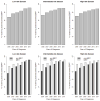Increasing use of dose-escalated external beam radiation therapy for men with nonmetastatic prostate cancer
- PMID: 24725694
- PMCID: PMC4049263
- DOI: 10.1016/j.ijrobp.2014.01.050
Increasing use of dose-escalated external beam radiation therapy for men with nonmetastatic prostate cancer
Abstract
Purpose: To examine recent practice patterns, using a large national cancer registry, to understand the extent to which dose-escalated external beam radiation therapy (EBRT) has been incorporated into routine clinical practice for men with prostate cancer.
Methods and materials: We conducted a retrospective observational cohort study using the National Cancer Data Base, a nationwide oncology outcomes database in the United States. We identified 98,755 men diagnosed with nonmetastatic prostate cancer between 2006 and 2011 who received definitive EBRT and classified patients into National Comprehensive Cancer Network (NCCN) risk groups. We defined dose-escalated EBRT as total prescribed dose of ≥75.6 Gy. Using multivariable logistic regression, we examined the association of patient, clinical, and demographic characteristics with the use of dose-escalated EBRT.
Results: Overall, 81.6% of men received dose-escalated EBRT during the study period. The use of dose-escalated EBRT did not vary substantially by NCCN risk group. Use of dose-escalated EBRT increased from 70.7% of patients receiving treatment in 2006 to 89.8% of patients receiving treatment in 2011. On multivariable analysis, year of diagnosis and use of intensity modulated radiation therapy were significantly associated with receipt of dose-escalated EBRT.
Conclusions: Our study results indicate that dose-escalated EBRT has been widely adopted by radiation oncologists treating prostate cancer in the United States. The proportion of patients receiving dose-escalated EBRT increased nearly 20% between 2006 and 2011. We observed high utilization rates of dose-escalated EBRT within all disease risk groups. Adoption of intensity modulated radiation therapy was strongly associated with use of dose-escalated treatment.
Copyright © 2014 Elsevier Inc. All rights reserved.
Conflict of interest statement
Figures
References
-
- Viani GA, Stefano EJ, Afonso SL. Higher-than-conventional radiation doses in localized prostate cancer treatment: a meta-analysis of randomized, controlled trials. Int J Radiat Oncol Biol Phys. 2009 Aug 1;74(5):1405–1418. - PubMed
-
- Zietman AL, Bae K, Slater JD, et al. Randomized trial comparing conventional-dose with high-dose conformal radiation therapy in early-stage adenocarcinoma of the prostate: long-term results from proton radiation oncology group/american college of radiology 95–09. J Clin Oncol. 2010 Mar 1;28(7):1106–1111. - PMC - PubMed
-
- Kuban DA, Tucker SL, Dong L, et al. Long-term results of the M. D. Anderson randomized dose-escalation trial for prostate cancer. Int J Radiat Oncol Biol Phys. 2008 Jan 1;70(1):67–74. - PubMed
-
- Dearnaley DP, Sydes MR, Graham JD, et al. Escalated-dose versus standard-dose conformal radiotherapy in prostate cancer: first results from the MRC RT01 randomised controlled trial. Lancet Oncol. 2007 Jun;8(6):475–487. - PubMed
-
- Peeters ST, Heemsbergen WD, Koper PC, et al. Dose-response in radiotherapy for localized prostate cancer: results of the Dutch multicenter randomized phase III trial comparing 68 Gy of radiotherapy with 78 Gy. J Clin Oncol. 2006 May 1;24(13):1990–1996. - PubMed
Publication types
MeSH terms
Substances
Grants and funding
LinkOut - more resources
Full Text Sources
Other Literature Sources
Medical


